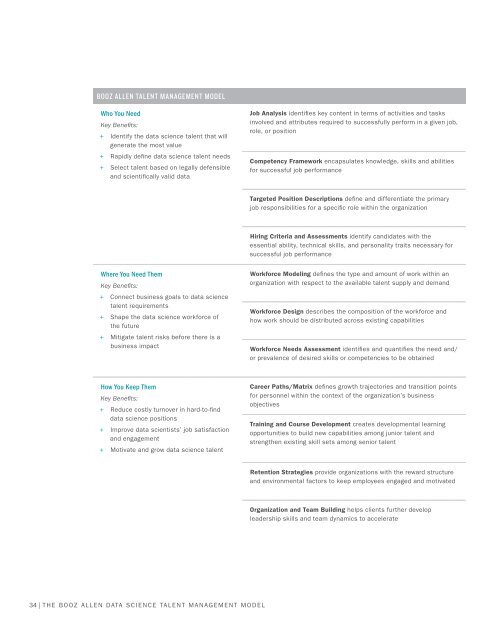Tips for Building a Data Science Capability
WH4vS
WH4vS
You also want an ePaper? Increase the reach of your titles
YUMPU automatically turns print PDFs into web optimized ePapers that Google loves.
BOOZ ALLEN TALENT MANAGEMENT MODEL<br />
Who You Need<br />
Key Benefits:<br />
+ + Identify the data science talent that will<br />
generate the most value<br />
+ + Rapidly define data science talent needs<br />
+ + Select talent based on legally defensible<br />
and scientifically valid data<br />
Job Analysis identifies key content in terms of activities and tasks<br />
involved and attributes required to successfully per<strong>for</strong>m in a given job,<br />
role, or position<br />
Competency Framework encapsulates knowledge, skills and abilities<br />
<strong>for</strong> successful job per<strong>for</strong>mance<br />
Targeted Position Descriptions define and differentiate the primary<br />
job responsibilities <strong>for</strong> a specific role within the organization<br />
Hiring Criteria and Assessments identify candidates with the<br />
essential ability, technical skills, and personality traits necessary <strong>for</strong><br />
successful job per<strong>for</strong>mance<br />
Where You Need Them<br />
Key Benefits:<br />
+ + Connect business goals to data science<br />
talent requirements<br />
+ + Shape the data science work<strong>for</strong>ce of<br />
the future<br />
+ + Mitigate talent risks be<strong>for</strong>e there is a<br />
business impact<br />
Work<strong>for</strong>ce Modeling defines the type and amount of work within an<br />
organization with respect to the available talent supply and demand<br />
Work<strong>for</strong>ce Design describes the composition of the work<strong>for</strong>ce and<br />
how work should be distributed across existing capabilities<br />
Work<strong>for</strong>ce Needs Assessment identifies and quantifies the need and/<br />
or prevalence of desired skills or competencies to be obtained<br />
How You Keep Them<br />
Key Benefits:<br />
+ + Reduce costly turnover in hard-to-find<br />
data science positions<br />
+ + Improve data scientists’ job satisfaction<br />
and engagement<br />
+ + Motivate and grow data science talent<br />
Career Paths/Matrix defines growth trajectories and transition points<br />
<strong>for</strong> personnel within the context of the organization’s business<br />
objectives<br />
Training and Course Development creates developmental learning<br />
opportunities to build new capabilities among junior talent and<br />
strengthen existing skill sets among senior talent<br />
Retention Strategies provide organizations with the reward structure<br />
and environmental factors to keep employees engaged and motivated<br />
Organization and Team <strong>Building</strong> helps clients further develop<br />
leadership skills and team dynamics to accelerate<br />
34 | THE BOOZ ALLEN DATA SCIENCE TALENT MANAGEMENT MODEL


